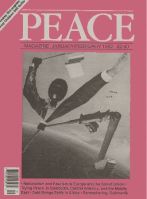
Peace Magazine Jan-Feb 1992, page 7. Some rights reserved.
Search for other articles by Ljuubinka Trgovcevic here
We recently received a letter from Nigel Young, professor of Peace Studies at Colgate University, reminding us of the plight of the people of Dubrovnik and the far-reaching concern they have elicited. He writes "Those who have enjoyed the warm hospitality and ancient treasures of Dubrovnik, especially the many scholars from around the world who have attended the Inter-University Centre of Postgraduate Studies, can send funds for medical supplies and humanitarian relief to the people of that stricken city through the initiative of Professor Orjar Oyen, Department of Sociology, University of Bergen, Norway, present director General of the IUC.
Checks should be sent to:
Account No.5235.05.11474
IUC Relief Assistance for Dubrovnik
Den norske Bank
N-5001 Bergen, Norway.
In honour of the scarred town of Dubrovnik and its people we reprint below excerpts from an article called Homage to Dubrovnik by Ljunbinka Trgovcevic of the Belgrade Historical Institute, which appeared in Yugofax in October.
Dubrovnik was first a Byzantine colony, then Norman, Venetian, Hungarian, Serbian, Turkish and Austrian. From the 12th century it was recognized as a city-commune. Between 1358 and 1808, it ran its own administrative and legislative affairs, but from 1815 on it was under French occupation, then Austrian, then after 1918, Yugoslavian. The walled city has a history of striving for independence against the ambitions of many conquerors.
Dubrovnik conquered through wisdom, not war. Instead of weapons, it defended itself through cooperation. By 1500 it had 22 consulates in the Mediterranean. At the end of the 17th century, 70. Dubrovnik thus became a symbol of interconnection with the world.
One side of the city opens to the sea, always drawing towards discovery. The other is surrounded by a hinterland intersected by numerous caravan routes to Bosnia, Montenegro, Serbia, then Byzantium, Hungary, Bulgaria, and then onwards to the Mediterranean and Europe. A key trading link between the Mediterranean and the Balkans, Dubrovnik was a bridge over which these worlds passed.
Instead of the insignia of czars, kings, or princes, Dubrovnik's coat of arms carried the sign of its protector, Saint Vlad. Its hymn, "O, beautiful, sweet, divine freedom I was a symbol of cooperation and negotiation, remembrance and hope.
During the recent fighting in Yugoslavia, both Croatians and Serbians used the city for cover, betting that no one would dare put it at risk. They were wrong. Skirmishes between Croatian police and Serbian forces led to a federal army assault on Dubrovnik, followed by a two week siege. It cut off all food, water and electricity and led to fighting within the city itself. Dressed in uniforms of similar styles and colours, some with checks, others with stars, some with beards. others without, soldiers used cannons, tanks, and rockets to pummel Dubrovnik.
In Belgrade more than 1,000 intellectuals and peace activists appealed to the army to relent. Without the famed archives of Dubrovnik, Serbia's history from the Middle Ages would be a tabula rasa. The same for Dalmatia, Bosnia, Croatia, and the Mediterranean. Those records could be at risk from an errant incendiary, or even a soldier's cigarette. Once again Dubrovnik imposes itself in the struggle between knowledge and ignorance.

Peace Magazine Jan-Feb 1992, page 7. Some rights reserved.
Search for other articles by Ljuubinka Trgovcevic here